Doubles game: Src-Stat3 versus p53-PTEN in cellular migration and invasion
- PMID: 20733006
- PMCID: PMC2953057
- DOI: 10.1128/MCB.00004-10
Doubles game: Src-Stat3 versus p53-PTEN in cellular migration and invasion
Abstract
We have recently shown that Src induces the formation of podosomes and cell invasion by suppressing endogenous p53, while enhanced p53 strongly represses the Src-induced invasive phenotype. However, the mechanism by which Src and p53 play antagonistic roles in cell invasion is unknown. Here we show that the Stat3 oncogene is a required downstream effector of Src in inducing podosome structures and related invasive phenotypes. Stat3 promotes Src phenotypes through the suppression of p53 and the p53-inducible protein caldesmon, a known podosome antagonist. In contrast, enhanced p53 attenuates Stat3 function and Src-induced podosome formation by upregulating the tumor suppressor PTEN. PTEN, through the inactivation of Src/Stat3 function, also stabilizes the podosome-antagonizing p53/caldesmon axis, thereby further enhancing the anti-invasive potential of the cell. Furthermore, the protein phosphatase activity of PTEN plays a major role in the negative regulation of the Src/Stat3 pathway and represses podosome formation. Our data suggest that cellular invasiveness is dependent on the balance between two opposing forces: the proinvasive oncogenes Src-Stat3 and the anti-invasive tumor suppressors p53-PTEN.
Figures
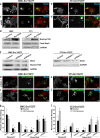


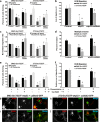
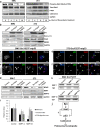
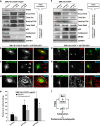

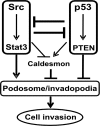
Similar articles
-
Both lipid- and protein-phosphatase activities of PTEN contribute to the p53-PTEN anti-invasion pathway.Cell Cycle. 2010 Nov 15;9(22):4450-4. doi: 10.4161/cc.9.22.13936. Epub 2010 Nov 15. Cell Cycle. 2010. PMID: 21084866
-
p53 suppresses Src-induced podosome and rosette formation and cellular invasiveness through the upregulation of caldesmon.Mol Cell Biol. 2009 Jun;29(11):3088-98. doi: 10.1128/MCB.01816-08. Epub 2009 Apr 6. Mol Cell Biol. 2009. PMID: 19349302 Free PMC article.
-
p53 regulation of podosome formation and cellular invasion in vascular smooth muscle cells.Cell Adh Migr. 2011 Mar-Apr;5(2):144-9. doi: 10.4161/cam.5.2.14375. Epub 2011 Mar 1. Cell Adh Migr. 2011. PMID: 21164280 Free PMC article. Review.
-
The Oncolytic Avian Reovirus p17 Protein Inhibits Invadopodia Formation in Murine Melanoma Cancer Cells by Suppressing the FAK/Src Pathway and the Formation of theTKs5/NCK1 Complex.Viruses. 2024 Jul 17;16(7):1153. doi: 10.3390/v16071153. Viruses. 2024. PMID: 39066315 Free PMC article.
-
IL-6/STAT3/ARF: the guardians of senescence, cancer progression and metastasis in prostate cancer.Swiss Med Wkly. 2015 Dec 21;145:w14215. doi: 10.4414/smw.2015.14215. eCollection 2015. Swiss Med Wkly. 2015. PMID: 26691865 Review.
Cited by
-
Identifying high-risk candidates for prolonging progression-free survival in primary gastric carcinoma subject to "double invasion": an analytical approach utilizing lasso-cox regression.BMC Cancer. 2025 Feb 28;25(1):381. doi: 10.1186/s12885-025-13810-z. BMC Cancer. 2025. PMID: 40022037 Free PMC article.
-
Polyphyllin VII induces apoptosis in HepG2 cells through ROS-mediated mitochondrial dysfunction and MAPK pathways.BMC Complement Altern Med. 2016 Feb 9;16:58. doi: 10.1186/s12906-016-1036-x. BMC Complement Altern Med. 2016. PMID: 26861252 Free PMC article.
-
Piperlongumine Attenuates High Calcium/Phosphate-Induced Arterial Calcification by Preserving P53/PTEN Signaling.Front Cardiovasc Med. 2021 Feb 10;7:625215. doi: 10.3389/fcvm.2020.625215. eCollection 2020. Front Cardiovasc Med. 2021. PMID: 33644124 Free PMC article.
-
Effects of p53-knockout in vascular smooth muscle cells on atherosclerosis in mice.PLoS One. 2017 Mar 31;12(3):e0175061. doi: 10.1371/journal.pone.0175061. eCollection 2017. PLoS One. 2017. PMID: 28362832 Free PMC article.
-
Cross-Kingdom Regulation of Putative miRNAs Derived from Happy Tree in Cancer Pathway: A Systems Biology Approach.Int J Mol Sci. 2017 Jun 3;18(6):1191. doi: 10.3390/ijms18061191. Int J Mol Sci. 2017. PMID: 28587194 Free PMC article.
References
-
- Artym, V. V., Y. Zhang, F. Seillier-Moiseiwitsch, K. M. Yamada, and S. C. Mueller. 2006. Dynamic interactions of cortactin and membrane type 1 matrix metalloproteinase at invadopodia: defining the stages of invadopodia formation and function. Cancer Res. 66:3034-3043. - PubMed
-
- Aylon, Y., and M. Oren. 2007. Living with p53, dying of p53. Cell 130:597-600. - PubMed
-
- Brisbin, S., J. Liu, J. Boudreau, J. Peng, M. Evangelista, and I. Chin-Sang. 2009. A role for C. elegans Eph RTK signaling in PTEN regulation. Dev. Cell 17:459-469. - PubMed
Publication types
MeSH terms
Substances
Grants and funding
LinkOut - more resources
Full Text Sources
Research Materials
Miscellaneous
